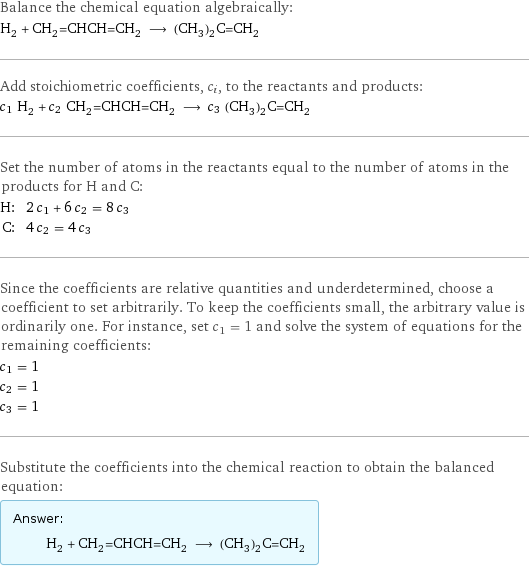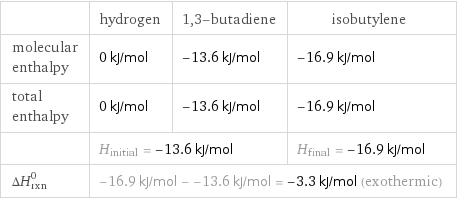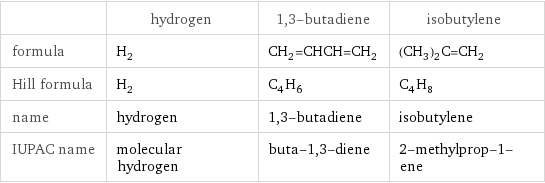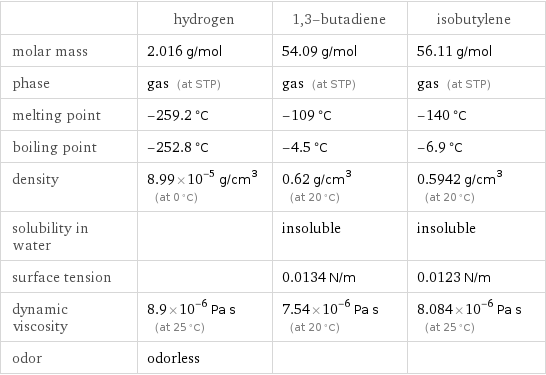Input interpretation

H_2 hydrogen + CH_2=CHCH=CH_2 1, 3-butadiene ⟶ (CH_3)_2C=CH_2 isobutylene
Balanced equation

Balance the chemical equation algebraically: H_2 + CH_2=CHCH=CH_2 ⟶ (CH_3)_2C=CH_2 Add stoichiometric coefficients, c_i, to the reactants and products: c_1 H_2 + c_2 CH_2=CHCH=CH_2 ⟶ c_3 (CH_3)_2C=CH_2 Set the number of atoms in the reactants equal to the number of atoms in the products for H and C: H: | 2 c_1 + 6 c_2 = 8 c_3 C: | 4 c_2 = 4 c_3 Since the coefficients are relative quantities and underdetermined, choose a coefficient to set arbitrarily. To keep the coefficients small, the arbitrary value is ordinarily one. For instance, set c_1 = 1 and solve the system of equations for the remaining coefficients: c_1 = 1 c_2 = 1 c_3 = 1 Substitute the coefficients into the chemical reaction to obtain the balanced equation: Answer: | | H_2 + CH_2=CHCH=CH_2 ⟶ (CH_3)_2C=CH_2
Structures

+ ⟶
Names

hydrogen + 1, 3-butadiene ⟶ isobutylene
Reaction thermodynamics
Enthalpy

| hydrogen | 1, 3-butadiene | isobutylene molecular enthalpy | 0 kJ/mol | -13.6 kJ/mol | -16.9 kJ/mol total enthalpy | 0 kJ/mol | -13.6 kJ/mol | -16.9 kJ/mol | H_initial = -13.6 kJ/mol | | H_final = -16.9 kJ/mol ΔH_rxn^0 | -16.9 kJ/mol - -13.6 kJ/mol = -3.3 kJ/mol (exothermic) | |
Equilibrium constant
![Construct the equilibrium constant, K, expression for: H_2 + CH_2=CHCH=CH_2 ⟶ (CH_3)_2C=CH_2 Plan: • Balance the chemical equation. • Determine the stoichiometric numbers. • Assemble the activity expression for each chemical species. • Use the activity expressions to build the equilibrium constant expression. Write the balanced chemical equation: H_2 + CH_2=CHCH=CH_2 ⟶ (CH_3)_2C=CH_2 Assign stoichiometric numbers, ν_i, using the stoichiometric coefficients, c_i, from the balanced chemical equation in the following manner: ν_i = -c_i for reactants and ν_i = c_i for products: chemical species | c_i | ν_i H_2 | 1 | -1 CH_2=CHCH=CH_2 | 1 | -1 (CH_3)_2C=CH_2 | 1 | 1 Assemble the activity expressions accounting for the state of matter and ν_i: chemical species | c_i | ν_i | activity expression H_2 | 1 | -1 | ([H2])^(-1) CH_2=CHCH=CH_2 | 1 | -1 | ([CH2=CHCH=CH2])^(-1) (CH_3)_2C=CH_2 | 1 | 1 | [(CH3)2C=CH2] The equilibrium constant symbol in the concentration basis is: K_c Mulitply the activity expressions to arrive at the K_c expression: Answer: | | K_c = ([H2])^(-1) ([CH2=CHCH=CH2])^(-1) [(CH3)2C=CH2] = ([(CH3)2C=CH2])/([H2] [CH2=CHCH=CH2])](../image_source/1b07e44df729a644edf32fa614674411.png)
Construct the equilibrium constant, K, expression for: H_2 + CH_2=CHCH=CH_2 ⟶ (CH_3)_2C=CH_2 Plan: • Balance the chemical equation. • Determine the stoichiometric numbers. • Assemble the activity expression for each chemical species. • Use the activity expressions to build the equilibrium constant expression. Write the balanced chemical equation: H_2 + CH_2=CHCH=CH_2 ⟶ (CH_3)_2C=CH_2 Assign stoichiometric numbers, ν_i, using the stoichiometric coefficients, c_i, from the balanced chemical equation in the following manner: ν_i = -c_i for reactants and ν_i = c_i for products: chemical species | c_i | ν_i H_2 | 1 | -1 CH_2=CHCH=CH_2 | 1 | -1 (CH_3)_2C=CH_2 | 1 | 1 Assemble the activity expressions accounting for the state of matter and ν_i: chemical species | c_i | ν_i | activity expression H_2 | 1 | -1 | ([H2])^(-1) CH_2=CHCH=CH_2 | 1 | -1 | ([CH2=CHCH=CH2])^(-1) (CH_3)_2C=CH_2 | 1 | 1 | [(CH3)2C=CH2] The equilibrium constant symbol in the concentration basis is: K_c Mulitply the activity expressions to arrive at the K_c expression: Answer: | | K_c = ([H2])^(-1) ([CH2=CHCH=CH2])^(-1) [(CH3)2C=CH2] = ([(CH3)2C=CH2])/([H2] [CH2=CHCH=CH2])
Rate of reaction
![Construct the rate of reaction expression for: H_2 + CH_2=CHCH=CH_2 ⟶ (CH_3)_2C=CH_2 Plan: • Balance the chemical equation. • Determine the stoichiometric numbers. • Assemble the rate term for each chemical species. • Write the rate of reaction expression. Write the balanced chemical equation: H_2 + CH_2=CHCH=CH_2 ⟶ (CH_3)_2C=CH_2 Assign stoichiometric numbers, ν_i, using the stoichiometric coefficients, c_i, from the balanced chemical equation in the following manner: ν_i = -c_i for reactants and ν_i = c_i for products: chemical species | c_i | ν_i H_2 | 1 | -1 CH_2=CHCH=CH_2 | 1 | -1 (CH_3)_2C=CH_2 | 1 | 1 The rate term for each chemical species, B_i, is 1/ν_i(Δ[B_i])/(Δt) where [B_i] is the amount concentration and t is time: chemical species | c_i | ν_i | rate term H_2 | 1 | -1 | -(Δ[H2])/(Δt) CH_2=CHCH=CH_2 | 1 | -1 | -(Δ[CH2=CHCH=CH2])/(Δt) (CH_3)_2C=CH_2 | 1 | 1 | (Δ[(CH3)2C=CH2])/(Δt) (for infinitesimal rate of change, replace Δ with d) Set the rate terms equal to each other to arrive at the rate expression: Answer: | | rate = -(Δ[H2])/(Δt) = -(Δ[CH2=CHCH=CH2])/(Δt) = (Δ[(CH3)2C=CH2])/(Δt) (assuming constant volume and no accumulation of intermediates or side products)](../image_source/d41992cf51acce42575268d2c2295761.png)
Construct the rate of reaction expression for: H_2 + CH_2=CHCH=CH_2 ⟶ (CH_3)_2C=CH_2 Plan: • Balance the chemical equation. • Determine the stoichiometric numbers. • Assemble the rate term for each chemical species. • Write the rate of reaction expression. Write the balanced chemical equation: H_2 + CH_2=CHCH=CH_2 ⟶ (CH_3)_2C=CH_2 Assign stoichiometric numbers, ν_i, using the stoichiometric coefficients, c_i, from the balanced chemical equation in the following manner: ν_i = -c_i for reactants and ν_i = c_i for products: chemical species | c_i | ν_i H_2 | 1 | -1 CH_2=CHCH=CH_2 | 1 | -1 (CH_3)_2C=CH_2 | 1 | 1 The rate term for each chemical species, B_i, is 1/ν_i(Δ[B_i])/(Δt) where [B_i] is the amount concentration and t is time: chemical species | c_i | ν_i | rate term H_2 | 1 | -1 | -(Δ[H2])/(Δt) CH_2=CHCH=CH_2 | 1 | -1 | -(Δ[CH2=CHCH=CH2])/(Δt) (CH_3)_2C=CH_2 | 1 | 1 | (Δ[(CH3)2C=CH2])/(Δt) (for infinitesimal rate of change, replace Δ with d) Set the rate terms equal to each other to arrive at the rate expression: Answer: | | rate = -(Δ[H2])/(Δt) = -(Δ[CH2=CHCH=CH2])/(Δt) = (Δ[(CH3)2C=CH2])/(Δt) (assuming constant volume and no accumulation of intermediates or side products)
Chemical names and formulas

| hydrogen | 1, 3-butadiene | isobutylene formula | H_2 | CH_2=CHCH=CH_2 | (CH_3)_2C=CH_2 Hill formula | H_2 | C_4H_6 | C_4H_8 name | hydrogen | 1, 3-butadiene | isobutylene IUPAC name | molecular hydrogen | buta-1, 3-diene | 2-methylprop-1-ene
Substance properties

| hydrogen | 1, 3-butadiene | isobutylene molar mass | 2.016 g/mol | 54.09 g/mol | 56.11 g/mol phase | gas (at STP) | gas (at STP) | gas (at STP) melting point | -259.2 °C | -109 °C | -140 °C boiling point | -252.8 °C | -4.5 °C | -6.9 °C density | 8.99×10^-5 g/cm^3 (at 0 °C) | 0.62 g/cm^3 (at 20 °C) | 0.5942 g/cm^3 (at 20 °C) solubility in water | | insoluble | insoluble surface tension | | 0.0134 N/m | 0.0123 N/m dynamic viscosity | 8.9×10^-6 Pa s (at 25 °C) | 7.54×10^-6 Pa s (at 20 °C) | 8.084×10^-6 Pa s (at 25 °C) odor | odorless | |
Units
